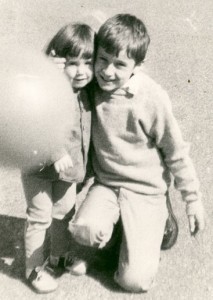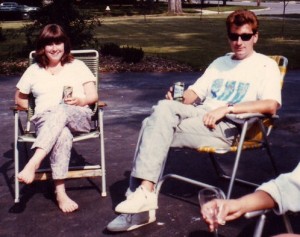“Leaving Las Vegas” is the Academy Award winning movie , starring Nicolas Cage and Elisabeth Shue, based on the novel by John O’Brien. The movie was directed by Hollywood outsider Mike Figgis, a man that loathes Backstory, ironically ended up directing a movie with the ultimate Backstory.
“I remember pitching ‘Hot Spots’ to four [studio] guys in monkey suits,” he says. “And someone asked, ‘What’s the backstory?’ Well, there was no backstory. The main character robbed banks. He was a bank robber, that’s what he did. But they couldn’t understand it without a ‘backstory,’ an elaborate explanation of how he got to where he got and why he got there.
And more and more, that’s what American movies are about: endless backstory, endless justification. If I’d wanted to make the backstory the movie, I would have!”
Interview with Mike Figgis: Director of “Leaving Las Vegas”: Baltimore Sun 12-17-95
Shortly after learning his novel Leaving Las Vegas was going to be made into a movie, John O’Brien committed suicide by a gun shot to the head, he did not leave behind a suicide note.
The story Leaving Las Vegas is about a down on his luck writer, Ben Sanderson, in Los Angeles that is deep in the throes of alcoholism. Ben is enticed to move to Las Vegas by the city’s 24-hour easy access to alcohol. Ben will utilize this easy access to alcohol to its fullest, as he plans to literally drink himself to death. While in Las Vegas he meets a prostitute named Sera, and a very unconventional romance ensues. As if that story isn’t poignant enough, add to it John O’Brien’s real life battles with alcoholism and you’ll discover a new level of pathos.
Letter From Erin O’Brien to Nicolas Cage
I spoke with Erin O’Brien, John’s sister, about John’s life in relation to the novel he wrote and the subsequent movie. As anyone who has lost someone close from a sudden death, particularly suicide, will attest, the search for connectedness to the loved one is intense and ongoing. Erin expressed this desire in a letter she wrote to Nicholas Cage, the actor that played Ben Sanderson in the movie.
We heard you would begin filming Leaving Las Vegas this fall. I realize the film may be quite different from John’s novel, but I Can’t help feeling a deep personal attachment. Ben is a thinly veiled self portrait of John. My family and I are anticipating Hollywood’s interpretation of John’s novel with a strange, melancholy pride.
I was delighted to learn you would be playing the part of Ben. The character seems consistent with your work, which I have enjoyed for many years. I feel compelled to make connections with the fragments he left behind. You are an unexpected and welcome participant in John’s aftermath.
Excerpt of a Letter From Erin O’Brien to Actor Nicolas Cage
Erin and her father have been quoted repeatedly in the press as saying: “Leaving Las Vegas was John’s suicide note.” The backstory of John’s life in relation to both the novel and movie Leaving Las Vegas is the ultimate version of Art imitating Life with the added permutation of Life imitating Art.
Leaving Las Vegas: From Book to Movie
The movie follows the novel rather closely, particularly on the point that John was most concerned about, No Feel Good Happy Ending. However, there are some differences.
In the book Sera is the more primary character, while Ben is clearly the primary character in the movie. In the book, Ben doesn’t really appear until page 59, in a 189 page book. I say “really appear” because when I mentioned this to Erin, who has read the book ten times versus my single close reading, she pointed to a passage on page 4 in the book where Sera sees a staggering drunk collapse directly in front of her. The next time Ben and Sera meet is page 139, where Sera reminds Ben: “You Know I saw you last week,” she says taking another exploratory step, “I saw you fall down on the sidewalk” They have a mere 50 pages together in the novel.
In the novel, John O’Brien occasionally gives Sera rather extravagant language. I doubt doppelganger or lugubrious are in common usage among the prostitutes in Las Vagas, perhaps John was prescient and knew Harvard educated Elisabeth Shue would end up playing Sera. However, when you read a character’s incongruous word usage it is a bit of a hard stop, as if you see the writer’s hand. When I mentioned this to Erin, she said those are her favorite parts of Leaving Las Vegas, because in those slips, she can see her brothers presence most fully.
As a side note what is it about having an Ivy-League education that seems to drive female actors to play prostitutes in movies:
In addition to Elisabeth Shue Harvard 89′; Mira Sorvino Harvard 89′ Mighty Aphrodite; Jody Foster Yale 84′ Taxi Driver; Brooke Shields Princeton 87′ Pretty Baby.
Leaving Las Vegas: The Guidebook
There are parts of Leaving Las Vegas that read like an alcoholics guide to drinking in Los Angeles.
So his life is punctuated by legislative break points and red flags of custom. At six a.m. the hardcore bars are open and the stores can sell, though they sometimes choose to withhold, imposing their morality on some poor, sweating, shaking mess looking for his fix. Nine a.m. is considered a safe opening time for bars that don’t like to admit that people drink that early but can’t let the business slip completely away;bartenders in these places tend to pause disapprovingly for an imperceptible moment before handing over a drink.
The Next milestone is eleven-thirty. At eleven-thirty everyone is willing to admit that the drinking day has begun and proudly open their doors and pour their drinks. It’s smooth sailing until midnight, when, if they haven’t already, the more reputable bars bail out. Any place that stays open past midnight is probably good until two– actually one-forty-five– the most important time of all. Never let two o’clock happen unless there is more liquor in the house than you could possibly drink in four hours–no small quantity.
“Leaving Las Vegas” pages 64-65
As the above passage describes just how focused Ben is on maintaining continuous access to alcohol. That four hour gap, 2am-6am, is just too long for Ben, he needs a place with 24-hour easy access to alcohol. Hence his move to Las Vegas, and a room at the Whole Year Inn, which Ben reads as the Hole You’re In. That pun seems to hearken back to the family vacations that John took, and would joke with Erin about the exit for Bluff City Illinois en route to their grandparents house.
Leaving Las Vegas: True To Life
John O’Brien’s alcoholism was so severe that he suffered from delirium tremens or DTs as they’re often referred to, which often includes hallucinations and severe tremors.
Erin O’Brien describes how John recounted one of his delirium tremens (DTs) episodes:
During the last moments before he surfaced from the live-action nightmare, everything stopped at once. Then an angelic female voice pierced the blackness, crystalline and sweet. ”We’ve lost you,” she lilted, “but we’ll get you back.” John startled to a shaking, sweating consciousness, more terrified by the surreal voice than the oily devil breaking through the wall that had filled the screen of his mind just before it gave way to the singing woman.
In the novel Ben repeatedly refers to Sera as an angel, combined with his severely intoxicated state throughout most of the novel, one wonders whether Sera is corporal or simply a figment of Ben’s imagination. The fact that John had hallucinations of an angelic female voice, only bolsters this possibility.
Leaving Las Vegas: The Final Draft
The hands of Mike Figgis are all over the film Leaving Las Vegas, not only did he direct the film, he wrote the screenplay adaptation, plus he was responsible for the film’s musical score, all of which were crucial to the film’s success. Mike’s background is more on the music side, rather than film. The haunting, jazz laden soundtrack that runs throughout Leaving Las Vegas acts as the third main character in the film.
‘The music [in Leaving Las Vegas] is more theatrical. It’s much more present. It has a much more personal voice than film music is expected to have. Film music is expected to be polite, it’s meant to hit buttons on cue, to let you know that you should cry, or be frightened, and when your heart should beat faster, and it has a very limited functional value. It’s very sentimental. It’s never meant to crossover into the narrative, but I think it should.’
You can sample some of the music in the trailer to Leaving Las Vegas. It’s unfortunate that the trailer pitches the movie, almost as romantic comedy, the movie is much more serious, definitely darker, but in a good way. The movie is the final polished draft of John O’Brien’s harsh and informed study of alcoholic despair.
Leaving Las Vegas is the first novel by John O’Brien and as such it should be judged more on the promise of the writer rather than merely the quality of the the finished work. There are passages in Leaving Las Vegas where the writer clearly shows his hand a bit too obviously, a common mistake among new writers. However, there are also passages that show the future promise of a talented writer, hence, John O’Brien’s suicide is loss to not only his friends and family but to the literary community at large.
You can follow Erin O’Brien’s writings on her blog:


 Follow VegasMavens on Twitter
Follow VegasMavens on Twitter 